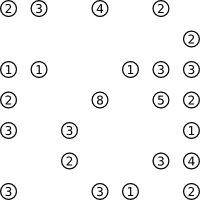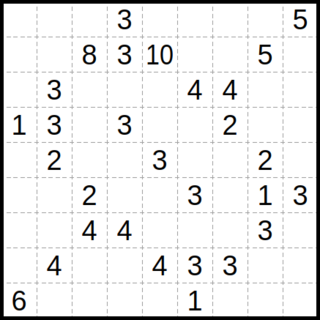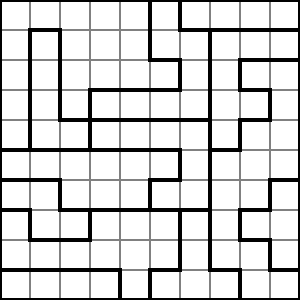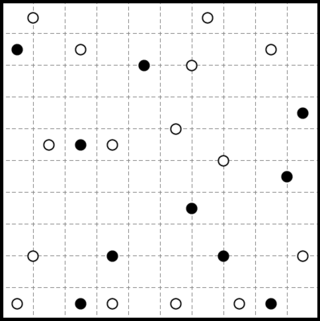
Gokigen Naname, also known as Slant, [1] is a binary-determination logic puzzle published by Nikoli. [2]

Gokigen Naname, also known as Slant, [1] is a binary-determination logic puzzle published by Nikoli. [2]
Gokigen Naname is played on a rectangular grid in which numbers in circles appear at some of the intersections on the grid.
The object is to draw diagonal lines in each cell of the grid, such that the number in each circle equals the number of lines extending from that circle. Additionally, it is forbidden for the diagonal lines to form an enclosed loop. Unlike many of Nikoli's similar puzzles, such as Hashiwokakero, a single network of lines is not required.






Kakuro or Kakkuro or Kakoro is a kind of logic puzzle that is often referred to as a mathematical transliteration of the crossword. Kakuro puzzles are regular features in many math-and-logic puzzle publications across the world. In 1966, Canadian Jacob E. Funk, an employee of Dell Magazines, came up with the original English name Cross Sums and other names such as Cross Addition have also been used, but the Japanese name Kakuro, abbreviation of Japanese kasan kurosu, seems to have gained general acceptance and the puzzles appear to be titled this way now in most publications. The popularity of Kakuro in Japan is immense, second only to Sudoku among Nikoli's famed logic-puzzle offerings.

Sudoku is a logic-based, combinatorial number-placement puzzle. In classic Sudoku, the objective is to fill a 9 × 9 grid with digits so that each column, each row, and each of the nine 3 × 3 subgrids that compose the grid contains all of the digits from 1 to 9. The puzzle setter provides a partially completed grid, which for a well-posed puzzle has a single solution.

Nurikabe is a binary determination puzzle named for Nurikabe, an invisible wall in Japanese folklore that blocks roads and delays foot travel. Nurikabe was apparently invented and named by Nikoli; other names for the puzzle include Cell Structure and Islands in the Stream.
Nikoli Co., Ltd. is a Japanese publisher that specializes in games and, especially, logic puzzles. Nikoli is also the nickname of a quarterly magazine issued by the company in Tokyo. Nikoli was established in 1980, and became prominent worldwide with the popularity of Sudoku.

Hitori is a type of logic puzzle published by Nikoli.

Hashiwokakero is a type of logic puzzle published by Nikoli. It has also been published in English under the name Bridges or Chopsticks. It has also appeared in The Times under the name Hashi. In France, Denmark, the Netherlands, and Belgium it is published under the name Ai-Ki-Ai.

Fillomino (フィルオミノ) is a type of logic puzzle published by many publishers. Other published titles for the puzzle include Allied Occupation.

LITS, formerly known as Nuruomino (ヌルオミノ), is a binary determination puzzle published by Nikoli.

Masyu is a type of logic puzzle designed and published by Nikoli. The purpose of its creation was to present a puzzle that uses no numbers or letters and yet retains depth and aesthetics.

Heyawake is a binary-determination logic puzzle published by Nikoli. As of 2013, five books consisting entirely of Heyawake puzzles have been published by Nikoli. It first appeared in Puzzle Communication Nikoli #39.

Where are the black cells?, abbreviated Kuromasu or Kurodoko, is a binary-determination logic puzzle published by Nikoli. As of 2005, one book consisting entirely of Kuromasu puzzles has been published by Nikoli.

Ripple Effect is a logic puzzle published by Nikoli. As of 2007, two books consisting entirely of Ripple Effect puzzles have been published by Nikoli. The second was published on October 4, 2007.

Slitherlink is a logic puzzle developed by publisher Nikoli.
Light Up, also called Akari is a binary-determination logic puzzle published by Nikoli. As of 2011, three books consisting entirely of Light Up puzzles have been published by Nikoli.

This is a glossary of Sudoku terms and jargon. It is organized thematically, with links to references and example usage provided as ([1]). Sudoku with a 9×9 grid is assumed, unless otherwise noted.

Inshi no heya is a type of logic puzzle published by Nikoli. It is a specific form of the KenKen puzzle genre where every operation is implied to be multiplication.

Bag is a binary-determination logic puzzle published by Nikoli.
Keisuke is a logic puzzle published by Nikoli.
Takuzu, also known as Binairo, is a logic puzzle involving placement of two symbols, often 1s and 0s, on a rectangular grid. The objective is to fill the grid with 1s and 0s, where there is an equal number of 1s and 0s in each row and column and no more than two of either number adjacent to each other. Additionally, there can be no identical rows or columns. Similar to Sudoku, each puzzle begins with several squares in the grid already filled.

Tentai Show, also known by the names Tentaisho, Galaxies, Spiral Galaxies, or Sym-a-Pix, is a binary-determination logic puzzle published by Nikoli.